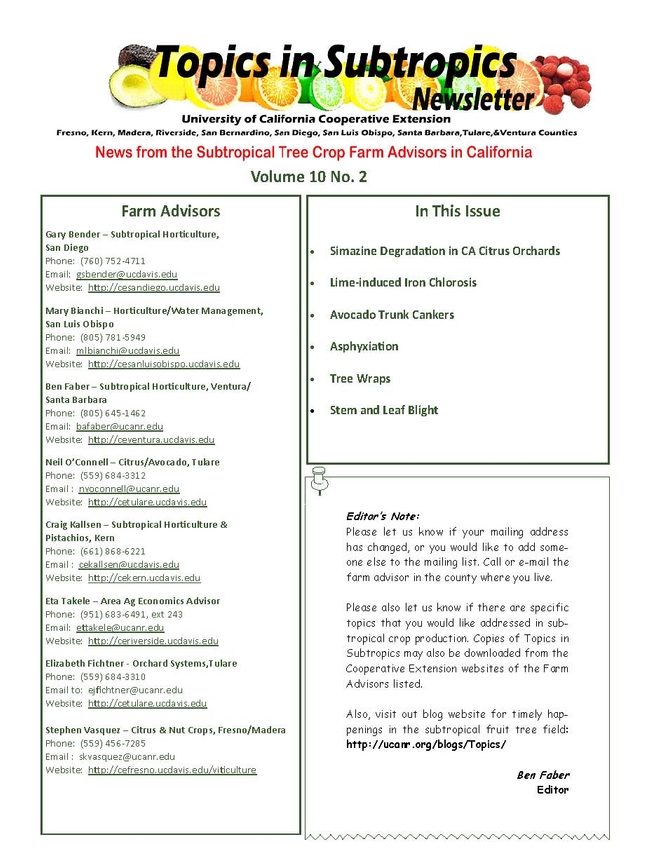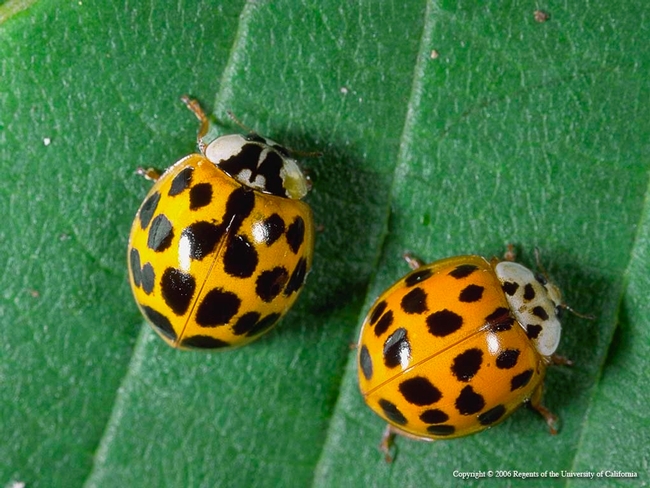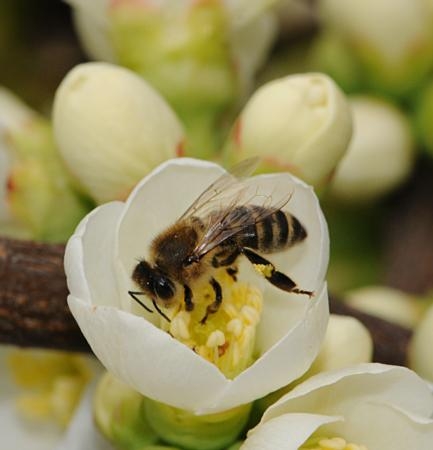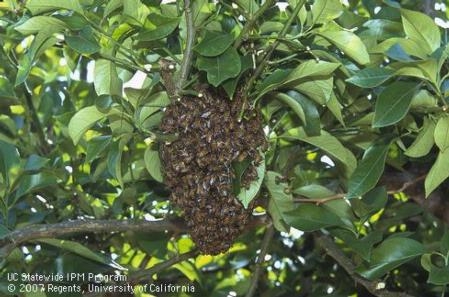- Author: Cris L. Johnson

Pollination is crucial to the survival of much of our ecosystems and maintaining viable environments for them to thrive provides not only benefits personal outdoor space, but adds to the well being of the community at large.
This publication focuses on ways to make your garden and outdoor environment more attractive to pollinators by identifying pollinators and the plants and landscaping practices that appeal to them.
ANR Publication 8498 is free of charge and available as a downloadable PDF.
You can download this publication here.
- Author: Cris L. Johnson

The latest issue has recently been posted on our website and features articles on:
Cultural Practices to Reduce Pest and Disease in Avocado and Citrus. This article by UC Ventura County Cooperative Extension advisor Dr. Ben Faber provides guidelines for practices from selection to maintenance that can mitigate disease and pests in trees.
Polyphagous Shot Hole Borer in California. UC Cooperative Extension cross-county advisor Dr. Sabrina Drill discusses this pest and it's effects on Southern Californian trees.
Electronic "sniffer" for Detecting HLB. Dr. Faber also reports on a new device that can detect Huanglongbing (HBL) disease in trees. Learn more about how it works and the advantage it could provide in preventing HLB spread through early detection.
Important Information Sources Related to Fire Management and Protection. The fire season is still on us and this list of online and publshed resources provides useful information for property owners.
Bee Kill in Oregon - A reminder of pesticide use. The State of Oregon has issued a moratorium on an aphid control pesticide after its use killed a large amount of bumble bees. Read more about following the proper guidelines on pesticide use here.
Read the full articles from this newsletter or check out other issues of Topics in Subtropics here.
- Author: Cris L. Johnson

The meeting is a day of presentations and discussions on topics related to insects. Dr. Downer, an expert plant pathologist, will talk about insects that damage oaks. Bee expert, Anna Howell, will contribute a talk on using native bees for pollination.
Four hours of DPR CEU's are applied for.
Date: Tuesday, March 19, 2013
Time: 9:00 am to 4:00 pm
Location:
Los Angeles County Arboretum and Botanic Garden
301 N. Baldwin Ave.
Arcadia, CA 91007
Registration: At the door. Free for members. $15 for nonmembers.
Contact: Jim Downer, 805-645-1458
For more information see the flyer here.
Learn more about the Entomological Association of Southern California here.
- Author: Chris M. Webb
Recently our office has received many calls about bee swarms. These calls are typical at this time of year. Each swarm can contain 5,000 to 20,000 bees.
Understandably bee swarms can cause uneasiness to residents unfamiliar with honey bees. While the swarms might seem frightening, the common honey bee is extremely docile. Unless they feel threatened they are unlikely to react defensively.
Swarming bees are in search of a new home. Honey bees prefer dark cavities with an easily defendable entrance at least 9 feet from the ground. Hollowed out trees are ideal sites, but other favored sites include: inside walls of houses, in or around chimneys, in outbuildings, fences, shrubs, water meters, utility boxes, barbecue grills, or under decks.
To learn more about honey bee swarms and hives, please see UC’s Removing Honey Bee Swarms and Established Hives.
Topics include:
- What is a bee swarm?
- Damage
- Swarm clusters
- Preventing establishment of a colony in your home
- Removing established colonies from your home
- Preventing future invasions
- Finding professionals to assist with colony extractions
- Author: Chris M. Webb
Pollinators are vital to our food and ecosystems. Many of the pollinators we depend on are in decline.
Five years ago, the U.S. Congress designated the last week in June as National Pollinator Week. The Secretary of the USDA signs a proclamation each year.
The Pollinator Partnership provides much information about pollinators, their importance, as well as the purpose of Pollinator Week.
From their website:
"Pollinator Week has now grown to be an international celebration of the valuable ecosystem services provided by bees, birds, butterflies, bats and beetles. The growing concern for pollinators is a sign of progress, but it is vital that we continue to maximize our collective effort…Pollinating animals, including bees, birds, butterflies, bats, beetles and others, are vital to our delicate ecosystem, supporting terrestrial wildlife, providing healthy watershed, and more. Therefore, Pollinator Week is a week to get the importance of pollinators’ message out to as many people as possible. It's not too early to start thinking about an event at your school, garden, church, store, etc. Pollinators positively effect all our lives- let's SAVE them and CELEBRATE them!"
The Pollinator Partnership has many free resources designed to help make your celebration powerful and informative. A collection of guides, fast facts and general information are also available to help people, industry and communities support pollinator populations.
National Pollinator Week is observed in June. Now is a great time to start preparing with your group to celebrate pollinators while educating others!





